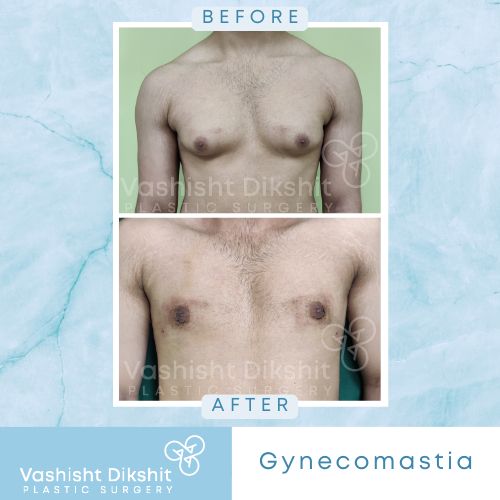Gynecomastia, or the enlargement of male breast tissue, is a condition that affects many men, causing both physical and emotional discomfort. It occurs due to an imbalance between testosterone and estrogen, leading to the growth of glandular breast tissue. While often benign, gynecomastia can be a source of insecurity, especially when it becomes visible through clothing or causes pain and tenderness.
Dr. Vashisht Dikshit, a highly experienced and internationally trained plastic surgeon based in Mumbai, specializes in treating gynecomastia. With a deep understanding of the hormonal causes behind this condition, Dr. Dikshit ensures that his patients receive comprehensive care to identify the root cause and choose the most effective treatment.
Here, we will explore the hormonal imbalances that contribute to gynecomastia and discuss how to diagnose and treat this condition under the expert care of Dr. Vashisht Dikshit.
What is Gynecomastia?
Gynecomastia is a condition that results in the enlargement of glandular breast tissue in males. This is different from simple fat accumulation (also known as pseudogynecomastia), as it involves the growth of actual breast gland tissue. The primary cause of this condition is an imbalance in hormones, particularly testosterone and estrogen.
While testosterone is typically responsible for male characteristics such as muscle mass and body hair, estrogen, which is present in much lower amounts in men, promotes the development of breast tissue. When the balance between these hormones shifts, either due to a decrease in testosterone or an increase in estrogen, the development of breast tissue can occur, leading to gynecomastia.
Key Symptoms of Gynecomastia
Recognizing the symptoms of gynecomastia is essential for seeking early treatment. Some of the common signs include:
- Swollen breast tissue or noticeable breast growth
- Breast tenderness or pain
- Enlargement of one or both breasts, leading to enlarged breasts
- Presence of breast buds or lumps under the nipples
- Nipple discharge (in rare cases)
- General discomfort or sensitivity around the chest area
In many cases, these symptoms can cause significant anxiety, as men may fear conditions like breast cancer. However, gynecomastia is typically benign, and seeking medical advice can help determine the correct diagnosis and treatment path.
Hormonal Imbalance: The Root Cause of Gynecomastia
Gynecomastia is primarily driven by hormonal imbalances. In men, the balance between testosterone and estrogen is crucial. Testosterone controls male physical traits, while estrogen, although present in small amounts, promotes breast tissue growth. When this delicate balance is disrupted, men may experience the growth of glandular breast tissue.
Below are common factors that can cause hormonal imbalances leading to gynecomastia:
- Natural Hormonal Fluctuations:
- During puberty, hormone levels can fluctuate wildly, causing temporary pubertal gynecomastia.
- As men age, testosterone production naturally declines, and estrogen levels may relatively increase, leading to idiopathic gynecomastia in older men.
- Medical Conditions:
- Kidney failure or liver disease, particularly liver failure, can disrupt normal hormone regulation.
- Disorders of the pituitary glands or adrenal glands can affect the balance of hormones and contribute to the growth of breast tissue.
- Serious illnesses such as testicular cancer or prostate cancer may also alter hormone levels, leading to gynecomastia.
- Medications and Drugs:
- Some prescription medications can interfere with the body’s hormone levels, including anti-anxiety medications, heart medications like calcium channel blockers, and antidepressant medications.
- Illicit drugs such as anabolic steroids, marijuana, and certain recreational drugs can also cause hormonal imbalances that trigger gynecomastia.
- Weight Gain:
- Excess adipose tissue (fat) can convert male hormones into estrogen, increasing the likelihood of gynecomastia, especially in men who are overweight or obese.
Diagnosing Gynecomastia: Identifying the Root Cause
Proper diagnosis of gynecomastia involves determining whether the breast enlargement is due to true gynecomastia (involving glandular breast tissue) or simply the accumulation of fat. Dr. Vashisht Dikshit takes a comprehensive approach, which includes:
1. Medical History:
Reviewing the patient’s medical history to identify any underlying health conditions, medication use, or lifestyle factors that could contribute to gynecomastia.
2. Physical Examination:
A thorough examination of the chest area to assess the presence of glandular tissue versus fatty tissue.
3. Blood Tests:
To measure hormone levels, including testosterone, estrogen, luteinizing hormone, and prolactin. These tests help pinpoint any hormonal imbalances.
4. Imaging Tests:
Ultrasound or mammography may be performed to evaluate the extent of breast tissue growth and to rule out other conditions, such as breast cancer.
5. Additional Testing:
In cases where the root cause is unclear, further evaluation of the pituitary and adrenal glands may be necessary to assess any glandular dysfunction.
Rediscover Confidence: Gynecomastia Solutions
Struggling with enlarged breasts? Gynecomastia treatment offers a transformative solution for men seeking a flatter, firmer chest. Our expert surgeons use advanced techniques to help you regain confidence and embrace a more masculine physique. Say goodbye to discomfort and hello to a new you!
Treatment Options for Gynecomastia
Once the root cause of gynecomastia is identified, treatment options can be explored. Dr. Vashisht Dikshit offers a range of treatments, from non-invasive approaches to gynecomastia surgery, depending on the severity and underlying cause.
1. Hormonal Therapy:
- If hormonal imbalances are the primary cause, addressing these imbalances through medication can be effective. For example, stopping medications that cause gynecomastia or balancing testosterone levels through hormone therapy may help reduce breast tissue growth.
2. Gynecomastia Surgery:
- For patients with significant breast tissue growth, Dr. Dikshit specializes in gynecomastia surgery (male breast reduction surgery). This involves the removal of glandular tissue, fatty tissue, and any excess skin to restore a masculine chest contour.
- The surgery is highly effective and can dramatically improve a patient’s quality of life by alleviating the physical and emotional discomfort associated with gynecomastia.
3. Lifestyle Modifications:
- For patients experiencing gynecomastia due to factors such as weight gain or drug use, adopting healthier lifestyle choices—including weight loss and avoiding recreational drugs—can significantly reduce the appearance of breast enlargement.
Why Choose Dr. Vashisht Dikshit for Gynecomastia Treatment in Mumbai?
Dr. Vashisht Dikshit is a renowned plastic surgeon with a deep commitment to providing personalized care or each of his patients. He takes the time to understand the root cause of every case of gynecomastia, offering a tailored treatment plan that ensures long-term satisfaction. Here’s why you can trust Dr. Dikshit for your gynecomastia treatment:
- Expertise:
Dr. Dikshit is highly skilled in identifying the hormonal imbalances that contribute to gynecomastia and providing effective treatment options, including advanced surgical techniques.
- Experience:
As one of Mumbai’s leading gynecomastia surgeons, he has helped countless men regain their confidence and achieve a more masculine chest appearance.
- Patient-Centered Approach: Dr. Dikshit ensures that every patient is well-informed, comfortable, and confident in their treatment decisions, prioritizing safety and patient satisfaction.

Dr. Vashisht's skilled gynecomastia surgery
Regain Your Confidence with Gynecomastia Treatment in Mumbai
Gynecomastia can affect both your physical appearance and emotional well-being. Fortunately, expert care from a specialist like Dr. Vashisht Dikshit can provide you with safe and effective solutions. Whether you need hormonal treatment or surgical intervention, Dr. Dikshit’s approach ensures that you achieve the best possible results.
For more information on gynecomastia treatment in Mumbai, or to schedule a consultation with Dr. Vashisht Dikshit, visit today. Don’t let gynecomastia affect your confidence—take the first step towards a better you.
Feel free to make an appointment with Dr. Vashisht Dikshit to learn more about male breast reduction surgery or hormonal treatment for gynecomastia in Mumbai. His expertise and patient-centric approach ensure that you’ll receive the best care possible.





